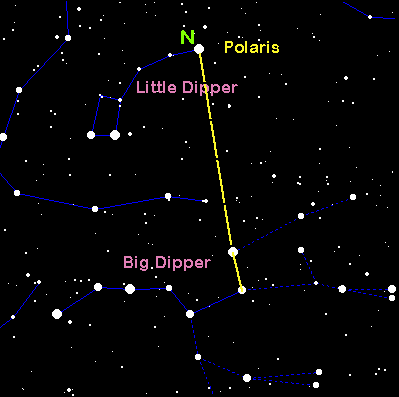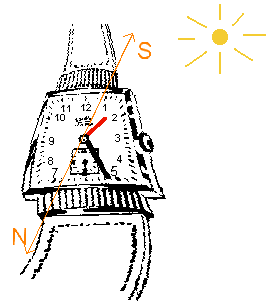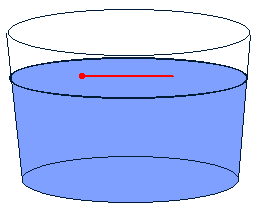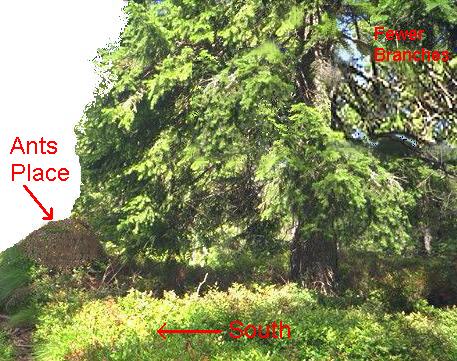Using a Compass: Illustrated "How-To" Tutorial, page 6
Methods for Navigating without a Compass
Navigating After the Stars at Night

You should, however, be careful with walking, it is easy to stumble and fall and get injured, and also easy to lose sight of the stars as you go, and you might start going around in circles. Often it will also be more physically and mentally demanding.
Big Dipper and PolarisIn the northern hemisphere, there is a star that is almost exactly in the north at all times, the Polaris. It is pretty easy to find, if you know the "Big Dipper." (Everybody knows the Big Dipper (or the Plough)?) Take the two stars at the end of the "Big Dipper," and make an imaginary line "upwards", and extend it five times the distance between the two stars. There you have it - Polaris. That way is always north. The figure is courtesy of Kathy Miles.
In the southern hemisphere, you would have to find the Southern Cross. Because I have not been south of the equator, I cannot help you find it, make someone tell you where it is right now, if you do not know it already. That way is south.
Navigating with Wristwatch

If you have an analog wrist watch, you can use the time to find north. Hold your watch up in front of you, and let the short hand, red on the figure, that indicates hours point at the sun. While holding it like this, cut the angle between the red arrow and 12 o'clock in two, (noonwards if the time is before 6am or after 6pm), that way is south. (The reason you need to cut it in two, is because the clock takes two rotations while the sun takes one around the earth, it is of course the other way around, but never mind.)
Many people wear digital watches these days (I do myself, if I wear one at all). If you do, draw an analog watch face on a piece of paper, and then mark the hour hand on using the digital watch. The rest of the method is identical.
This method can be used even when it is pretty foggy. Although you may not be able to see the sun, it may still cast a shadow. If you take up a straw or a tiny stick, and you may see a shadow. You just have to remember that the shadow points the opposite way from the sun, but the rest of it is quite similar as above.
Making Your Own Compass

Glass of water with needle Want to make your own compass? Sure. You need a needle and a glass of water. A needle can in fact float on the water, or that is, on the surface tension forces if put carefully on the surface. Just put it carefully down on the surface of the water. This demands a lot of patience though.
There are tricks that makes it go easier. Put the needle on a piece of paper. If the paper floats too, there is no problem, and if the paper sinks, it will probably leave the needle. If you put some grease on the needle that is not water-based, it will go easier, or if you put it carefully down with a fork or something. Once it has got there, it stays there pretty good.
If the needle is magnetic, it will act as a normal compass and be very accurate. A problem is though, that you do not know north from south. All you know is that it lays north-south. You would have to use one of the other techniques to find out, or make a good guess.
The greatest problem with this is: Not many needles are made of magnetic materials these days.... You cannot just use any needle. You may just have to look around to see what you can find, if you want to make a yourself a compass.
A Few Methods Based On Natural Signs
Tree With an Ant's Nest

It is very much about trees. First of all, there will be fewer branches to the north. This is usually easiest to see if you look up along the trunk of the tree. The north face of the tree would be more humid than the south face, which is something most species of lichen (or moss) likes, and consequently, there will be more of it on the north face. On the image above, you can also see that ants likes to build their nests on the south side of the tree.
It is also worthwhile to look at how snow melts. In the spring in the mountains, snow will melt faster on the south face of rocks, or in south faced slopes. Also, vegetation and undergrowth will typically be thicker on the South facing slopes, and also fruits ripen earlier on the South facing slopes.
These methods are not very reliable, I am afraid. Winds may alter the average conditions significantly, and cause deviations. If you use natural signs, you should use as many signs as you can before you draw a conclusion.
This is an ad by Amazon. As an Amazon Associate I earn from qualifying purchases.